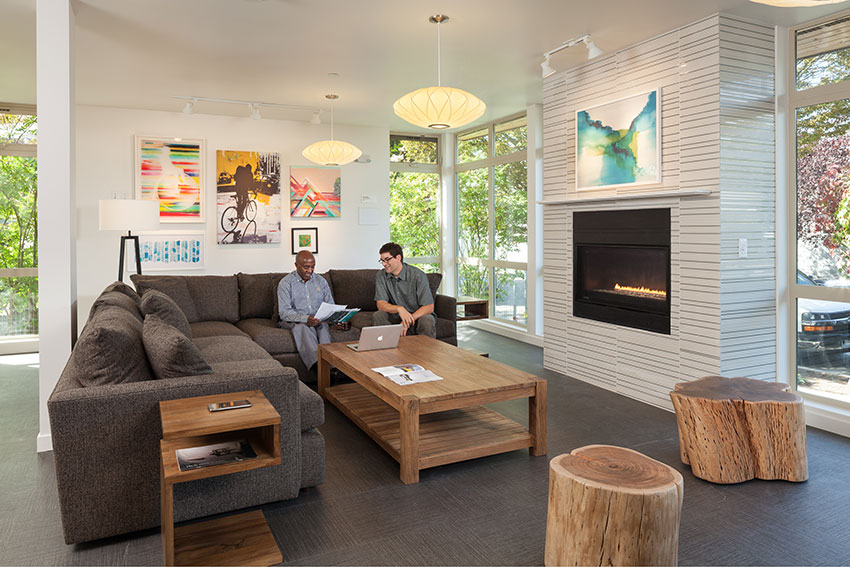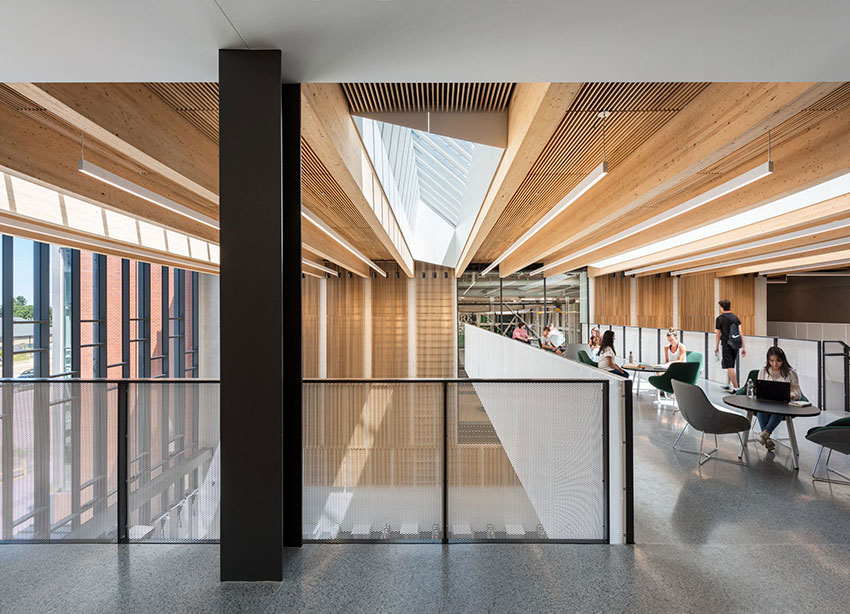Multi-Family, Mid-Rise Wood Buildings
Design Considerations For Framing With Wood
Traditional practices and code provisions for wood framing are established and well-known such that wood framing options and details are readily available to designers. Chapters 16, 17, and 23 of the IBC cover structural wood design, construction, and inspection techniques in considerable detail. However, in addition to selecting the appropriate framing technique, designers of wood buildings must consider factors such as shrinkage, differential movement, and seismic requirements.
Framing Types
There are three common types of framing for wood construction. For Type V-A buildings, where walls require a 1-hour fire-resistance rating, designers usually use traditional platform framing, where the joists sit on top of the double top plates of the wall. Balloon framing is based on the joists hanging off a ledger that is attached to the structural studs which frame the building. In modified or semi-balloon framing, the floor framing hangs off double top plates; it is often used as an alternative to platform-framed structures for both Type V-A and Type III-A construction.
Wood Shrinkage
Regardless of the framing type, IBC Section 2304.3.3 requires that designs for buildings over three stories consider the fact that wood shrinks as it dries. Shrinkage continues until wood reaches its Equilibrium Moisture Content (EMC), which averages 8 to 12 percent moisture content for most structures in the U.S.
Shrinkage effects must be considered for horizontal framing members (width or thickness) in the wall (top/sill plates) and floor (joists) design. Wood is anisotropic, meaning the dimensional change in wood is unequal in different directions. In most softwoods, radial shrinkage (across growth rings) is approximately 4 percent and tangential shrinkage (parallel to growth rings) is approximately 8 percent from green (unseasoned) to typical EMC for structures in the U.S. Longitudinal shrinkage (parallel-to-grain) for vertical framing members is generally negligible and does not affect building performance. Therefore, the majority of shrinkage will occur in the top plates, sill plate, and sole plates, and possibly the floor joists—depending on how the floor framing members are framed to the wall. If the design uses balloon- or modified balloon-framing, then sawn lumber joists won’t play a huge role in overall movement from shrinkage because balloon framing, unlike platform framing, does not accumulate shrinkage over all floors.
Initial MC, or MC at the time of manufacture, is typically specified on a project’s structural drawings. In many parts of the country, the specification would read “a maximum MC of 19 percent.” To achieve this, lumber is generally kiln dried. Although there are regional variations, less commonly used green lumber (which typically hasn’t been kiln dried and has a MC above 19 percent), surface dried lumber, or KD-15 (i.e., kiln dried lumber with a maximum MC of 15 percent at time of manufacture) may also be specified. The American Softwood Lumber Standard, PS 20, a voluntary product standard under the rules of the U.S. Dept. of Commerce, defines dry lumber as “lumber of less than nominal 5-inch thickness which has been seasoned or dried to a maximum moisture content of 19 percent.”
Ways to minimize shrinkage include (among others) specifying kiln dried lumber, letting the wood dry during construction before closing in the walls, and using products and systems such as pre-engineered metal-plate-connected wood trusses for floor and/or roof framing, and engineered wood products (laminated veneer lumber, I-joists, cross-laminated timber, etc.). I-joist floor systems are dimensionally stable and offer minimal inter-floor shrinkage.
Additionally, some overall settlement of the building may occur due to gaps in the building construction that can contribute to the overall vertical movement. Some designs will address this by distributing the dead load throughout the height of the building and allow time for the building to acclimate to the environment and/or air dry prior to installation of the drywall, thus allowing the building to naturally settle.
Fire Safety During Construction
Although less than 2 percent of building fires occur during construction, this phase presents unique risk scenarios that make any building more vulnerable, regardless of material used.
IBC Chapter 33 provides minimum safety precautions for fire during construction, and guidelines for the protection of adjacent public and private properties. The section also includes provisions for fire extinguishers, standpipes, means of egress, and sprinkler system commissioning. The International Fire Code also contains detailed requirements. Fire safety measures such as extended fire watches, site security, safety inspections, and record keeping are now incumbent on owners and contractors during construction.
The most common causes of fire in wood-framed buildings under construction are arson and hot work, making site security, rigorous procedures for workers, and access to fire hydrants critically important. Education is also important, since fires that occur during this phase can spread more quickly when required elements such as gypsum wall coverings, fire doors, smoke alarms, and sprinklers have not been put in place. The Construction Fire Safety Coalition is a resource for codes, standards, and best practices in fire prevention.
Differential Movement
Allowing for differential movement between wood and non-wood structural elements and building finishes is critical. Steel, concrete, and brick continue to expand and contract over time due to temperature changes, while wood generally maintains its dimensions after having reached its EMC.
Differential movement occurs when, for example, floor joists are supported by a wood-framed wall at one end and by the masonry block of an elevator shaft at the other end. Areas such as stairwells, shafts, and vaulted ceilings require attention for differential movements as do plumbing, electrical, and mechanical systems. Using flexible joints such as flexible pipe, conduit, couplings, and elbows and tees for electrical, mechanical, and plumbing between floors can prevent potential mechanical problems. Design of joints between building envelope components, such as windows and doors, must also allow for differential shrinkage.
Seismic Requirements
While earthquake and seismic requirements are a well-known aspect of building design on the west coast, other parts of the country are not immune to earthquake activity and must also comply with seismic codes. Wood construction provides high strength with relatively low weight, and the high strength-to-weight ratio makes wood a good choice for earthquake-resistant construction. In wood-framed buildings, walls and floors are often used to transfer lateral loads from winds and seismic forces.
Wood-frame construction also provides numerous load paths through shear walls and diaphragms, which typically have hundreds of structural elements and thousands of nail connections, adding ductility and redundancy to the system. Redundant load paths give additional assurance that loads will be transferred if one connection fails. In contrast, structures supported by heavy non-wood frames have relatively few structural members and connections, resulting in fewer load paths. Moreover, the large number of walls in a typical multifamily project reduces the loads shared by each individual wall. Tests and observations from past earthquakes show that wood buildings have performed well. For example, a six-story light-frame wood building tested on the world’s largest shake table in Japan resisted a major earthquake (projected to occur, on average, approximately every 2,500 years) with minimal damage.
Building code requirements for wood diaphragms, shear walls, and hold-down devices work effectively in creating earthquake-resistive structures. Horizontal diaphragms in roofs and floors transfer the horizontal forces to the shear walls. Shear walls with hold-downs, such as a continuous tie-down rod system, resist tension forces in an overturning scenario, while wood studs or columns absorb the compression forces. Wood structural panel shear walls are typically used throughout the building to provide vertical lateral resistance.
Acoustical Control
As with any type of building performance goal, the acoustics of a mixed-use and multifamily wood-framed building can be designed to meet or exceed minimal requirements, depending on the expectations of the developer, buyers, and tenants. Requirements for acoustical performance of floor and wall assemblies for multifamily buildings are covered in Section 1206 of the 2021 IBC. These assemblies must have STC (sound transmission class) and IIC (impact insulation class) ratings of 50 or higher. Ratings can be reduced to 45 if field-tested.
For wall systems, sound isolation can be accomplished in two ways. One is to use partitions with a high mass of 75 pounds per square foot (psf) or greater, or to use low-mass systems (2 to 5 psf) separated by air spaces of 3 to 6 inches. The goal in party walls or exterior walls is to keep other people’s noise out of the living unit, while keeping tenant noise in. In lightweight wood structures, this can be achieved by separating the materials with an air space (e.g., stud or joist construction). In terms of acoustical performance, the most effective wood-frame wall is a double-stud wall, followed by staggered-stud, and then single-stud configuration.
In mid-rise wood-frame buildings, some options for improving acoustic performance include:
The American Wood Council has developed Technical Report 15: Calculations of Sound Transmission Parameters for Wood-Framed Assemblies (TR15) as a tool to estimate STC and IIC sound ratings of floor/ceiling assemblies. Additionally, a calculator is available on the AWC website to simplify the calculation of these estimated STC and IIC values, using the methodology presented in TR15. In 2018, Sections 1206.2 and 1206.3 of the IBC were amended to allow STC and IIC sound ratings to be established by engineering analysis, creating the opportunity for design flexibility without the need for laboratory testing every assembly.
Mass timber buildings provide unique acoustical considerations, particularly since many designers want to leave the wood structure exposed as finish. Acoustic performance expectations can still be met for most designs. For example, concrete floor toppings are often added to mass timber floor assemblies to improve acoustics; sometimes, underlayments or acoustical mats are placed between the mass timber panel and the topping.












